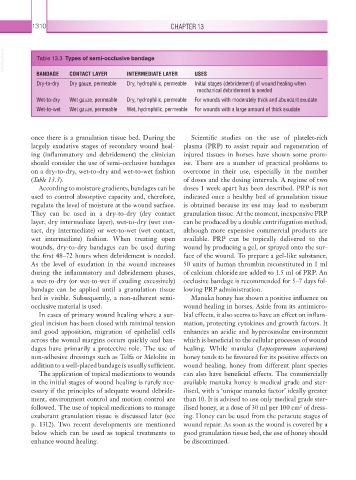Page 1335 - Equine Clinical Medicine, Surgery and Reproduction, 2nd Edition
P. 1335
1310 CHAPTER 13
VetBooks.ir Table 13.3 Types of semi-occlusive bandage
BANDAGE CONTACT LAYER INTERMEDIATE LAYER USES
Dry-to-dry Dry gauze, permeable Dry, hydrophilic, permeable Initial stages (debridement) of wound healing when
mechanical debridement is needed
Wet-to-dry Wet gauze, permeable Dry, hydrophilic, permeable For wounds with moderately thick and abundant exudate
Wet-to-wet Wet gauze, permeable Wet, hydrophilic, permeable For wounds with a large amount of thick exudate
once there is a granulation tissue bed. During the Scientific studies on the use of platelet-rich
largely exudative stages of secondary wound heal- plasma (PRP) to assist repair and regeneration of
ing (inflammatory and debridement) the clinician injured tissues in horses have shown some prom-
should consider the use of semi-occlusive bandages ise. There are a number of practical problems to
on a dry-to-dry, wet-to-dry and wet-to-wet fashion overcome in their use, especially in the number
(Table 13.3). of doses and the dosing intervals. A regime of two
According to moisture gradients, bandages can be doses 1 week apart has been described. PRP is not
used to control absorptive capacity and, therefore, indicated once a healthy bed of granulation tissue
regulate the level of moisture at the wound surface. is obtained because its use may lead to exuberant
They can be used in a dry-to-dry (dry contact granulation tissue. At the moment, inexpensive PRP
layer, dry intermediate layer), wet-to-dry (wet con- can be produced by a double centrifugation method,
tact, dry intermediate) or wet-to-wet (wet contact, although more expensive commercial products are
wet intermediate) fashion. When treating open available. PRP can be topically delivered to the
wounds, dry-to-dry bandages can be used during wound by producing a gel, or sprayed onto the sur-
the first 48–72 hours when debridement is needed. face of the wound. To prepare a gel-like substance,
As the level of exudation in the wound increases 50 units of human thrombin reconstituted in 1 ml
during the inflammatory and debridement phases, of calcium chloride are added to 1.5 ml of PRP. An
a wet-to-dry (or wet-to-wet if exuding excessively) occlusive bandage is recommended for 5–7 days fol-
bandage can be applied until a granulation tissue lowing PRP administration.
bed is visible. Subsequently, a non-adherent semi- Manuka honey has shown a positive influence on
occlusive material is used. wound healing in horses. Aside from its antimicro-
In cases of primary wound healing where a sur- bial effects, it also seems to have an effect on inflam-
gical incision has been closed with minimal tension mation, protecting cytokines and growth factors. It
and good apposition, migration of epithelial cells enhances an acidic and hyperosmolar environment
across the wound margins occurs quickly and ban- which is beneficial to the cellular processes of wound
dages have primarily a protective role. The use of healing. While manuka (Leptospermum scoparium)
non-adhesive dressings such as Telfa or Melolite in honey tends to be favoured for its positive effects on
addition to a well-placed bandage is usually sufficient. wound healing, honey from different plant species
The application of topical medications to wounds can also have beneficial effects. The commercially
in the initial stages of wound healing is rarely nec- available manuka honey is medical grade and ster-
essary if the principles of adequate wound debride- ilised, with a ‘unique manuka factor’ ideally greater
ment, environment control and motion control are than 10. It is advised to use only medical grade ster-
followed. The use of topical medications to manage ilised honey, at a dose of 30 ml per 100 cm of dress-
2
exuberant granulation tissue is discussed later (see ing. Honey can be used from the peracute stages of
p. 1312). Two recent developments are mentioned wound repair. As soon as the wound is covered by a
below which can be used as topical treatments to good granulation tissue bed, the use of honey should
enhance wound healing. be discontinued.

